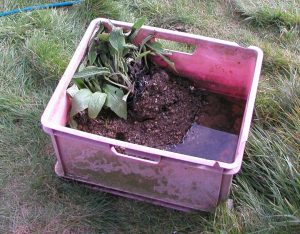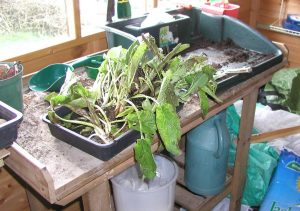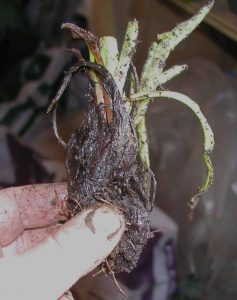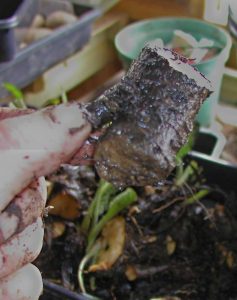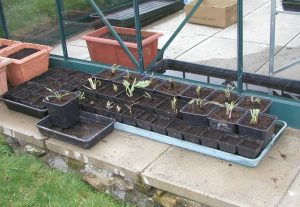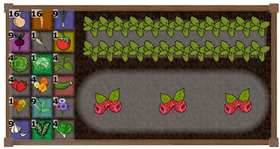The only variety of comfrey recommended and available for garden fertiliser & livestock feeding use is Bocking 14. In an ideal world you would also be able to obtain Bocking 4 which is more suitable as a livestock feed but this now seems to be unavailable in the UK. Bocking 14 is a sterile clone, which is fortunate because if it set viable seed you’d have it coming up everywhere in the area.
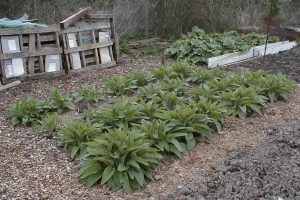 Herbalists use a different variety – common comfrey whereas Bocking 14 is a cross between Russian and Common comfrey.
Herbalists use a different variety – common comfrey whereas Bocking 14 is a cross between Russian and Common comfrey.
Bocking 14 is a sterile clone and doesn’t set viable seeds. Accordingly it is propagated from pieces of the plant like sets off the plant – offsets.
Initially you purchase or beg off a friend either pieces of root or pieces from the top of the plant known as crown offsets. Crown offsets get away a bit faster but root offsets are perfectly adequate.
Then cut the root into pieces around 5 to 7.5cm (2″ to 3″) long and plant those out.
From one half of a year old plant, I’ve obtained 42 offsets and a year later the original plant is as good as those you’ve not split.
Visual Guide to Propagating Comfrey
Split a plant into halves
Choose a strong mature plant and start by loosening the soil to one side with a fork. Insert a spade across the middle of the plant and cut straight down, splitting the plant in two. Dig up half and fill the hole left with compost or a compost and soil mix.
The half of the plant left in the ground will recover and be as productive as the other plants in the comfrey bed in a year’s time.
Take the lifted half of the plant and wash off the soil adhering to the roots. I found it easiest to use a plastic box and the spray nozzle on the hosepipe but a bucket of water would be fine.
Split the half plant into root and crown offsets
I take the cleaned half plant into the potting shed for this part. You’ll need a sharp knife for this part.
Start by cutting off the leaves leaving a very short stalk, about ½ an inch or 1 cm. At this point the leaves will demand more water than the root can supply and will not feed the root. Removing them allows the root time to recover and develop leaves of a size it can support.
Cut across the plant about 2-3″ or 5 to 7.5 cm from the top. This will give you your crown offsets.
Comfrey Crown & Root Offsets
Take the top slice of the plant and split into pieces using your knife. Some pieces around the edge will just break off naturally. Because they already have a growing tip and root, these get away very quickly and put on new leaves.
The term crown just refers to them being from the top of the plant.
The root offsets are just pieces of the root from lower down. These lack the growing tip and take a little longer to get away and put up leaves. Comfrey is like a dock weed, if you rotavate a patch splitting the roots up all you will do is create a lot of new plants. Once it is planted it is hard to get rid of!
Potting Up The Comfrey Offsets
You could plant your offsets directly into the ground and most likely they’ll thrive and grow. I prefer to start them off in pots though. This way they have the best chance of getting going as my soil is pretty poor.
I use 3″ (7.5cm) pots of multi-purpose compost which I keep moist but not water logged. The crown offsets are planted with the leaf tips just above the surface. Root offsets are planted about an inch down. With the root offsets it doesn’t really matter if you get them the right way up, but if in doubt go sideways.
Once the first leaves appear plant out – be quick as comfrey is very fast growing.
In the UK you can purchase both root and crown cuttings of Bocking 14 comfrey direct from the grower, Comfrey UK, growers of Comfrey Bocking 14 for over 20 years.
Further Information on Comfrey
- Growing & Using Comfrey for Gardeners
- Location & Preparing the Comfrey Bed
- How to Propagate Comfrey – Propagating Bocking 14 Comfrey
- Planting, Cultivation, Harvesting & Problems of Comfrey
- Comfrey – Medicinal Uses of Comfrey (Symphytum officinale)
- Using Comfrey: Making Comfrey Compost, Comfrey Liquid Feed or Tea
- Feeding Comfrey to Poultry and Other Livestock

